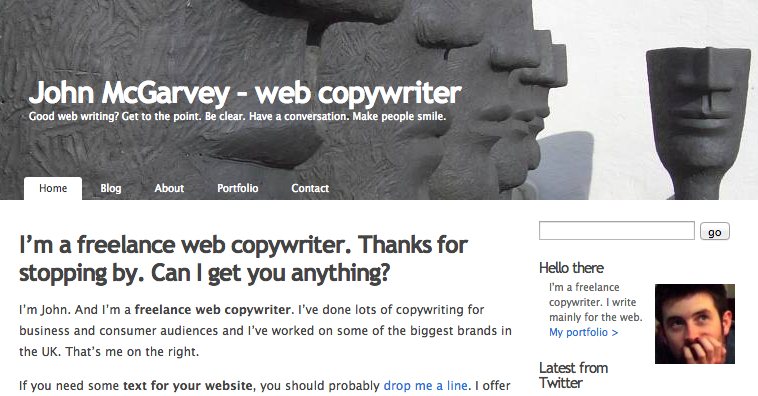
I first launched this website in early 2007, getting started with a blog post about contracting in large companies that’s surprisingly relevant even seven years on.
To be honest, ‘launched’ is a grand term for a site I threw together in a couple of hours. It was built on the versatile WordPress platform and I created it after deciding I needed some kind of online presence.
Low effort, decent rewards
That low-effort site served me well. When I decided to go freelance in 2008, I just had to make some minor changes. For a long time, it looked much like the screenshot above.
Those changes seemed to work. The site achieved decent search rankings for some relevant terms and even brought in a few clients.
But as time went by, my trusty web presence became something of an embarrassment.
When I first gave a talk espousing the value of good design and explaining that copywriting and web design are two sides of the same thing, it seemed ridiculous that my own site was built on a dated, out-of-the-box template.
A classic case of ‘do as I say, not do as I do’.
Enough was enough
A mere two years later, I decided enough was enough and started looking at the options for building a new site.
I considered using something like BaseKit to do it myself, or developing a new WordPress site to boost my technical skills. After all, in the dim and distant past I was good enough at coding to get a degree in Computer Science.
But I dismissed those ideas swiftly. I believe in good design and I respect the skills of designers who’ve spent years learning their craft.
I wanted to work with someone who had expertise, rather than cobbling something together.
Finding the right team
I ended up approaching several designers, any of whom I’d have happily worked with.
I eventually settled on Carabi + Co, a group of web professionals I’ve been part of for a couple of years.
Much hard work later and I’ve ended up with the site you see in front of you. Here’s who did what:
Oh, and I did the content, obviously.
That, in brief, is how I got here. Finally, I have a site that a web writer can be proud of.
Watch this space for a more detailed post about the process we went through to actually build this site.

Writing about the closure of Editorially got me thinking about how many free online apps I use.
And it got me wondering: what would happen if one of them closed tomorrow?
Is your information safe?
So, let’s take Editorially. The short blog post explaining its closure is accompanied by an FAQ, which contains this useful snippet of information:
“Will everything continue to work until the shutdown? Hopefully, but we can’t guarantee that. The founders will stay on to help with any issues that arise with the export tool, but we may not be able to fix unrelated bugs.”
In other words: you might rely on Editorially to run your business, but there are no guarantees it’s going to keep on working properly.
(If you do use Editorially, this is why you should export your data from the service as soon as you can.)
A word of warning about ‘free’
This post isn’t intended to direct criticism at Editorially. The service never made any promises about long-term availability and I think it’s admirable the founders have been so open about what happens next.
But what’s happened to Editorially is a timely warning. It’s easy to start using a free online app. If it’s good, you can soon come to depend on it.
For instance, I use Red Pen and Bounce to make notes on client mockups and wireframes. They’re brilliant ways to share ideas and feedback.
Because I don’t pay for these services, they don’t make any promises. They could close my account tomorrow, deleting all the screenshots I’ve uploaded and erasing all the comments I’ve made.
Think about the apps you use
The lesson here isn’t to avoid free apps that can make your life easier. They’re too useful for that. But do think about which ones you use and what you use them for.
If you’re starting to become reliant on a particular app, or find you’re using it to store lots of important information, check out the company behind the app and how their business works.
Are they well established? Do they have a paid-for product with a strong customer base? Is the app part of their core business, or does it feel like an extra project they might kill off? (Just look at what happened to Google Reader.)
It’s good to try new apps and there are lots of businesses creating interesting tools that deserve support.
But if there’s one you depend on day in, day out, do some homework so you can be confident it isn’t going to disappear when you need it most.
(Incidentally, both Red Pen and Bounce are run by established companies offering other products that are paid-for.)
Image from Flickr user Charles Dyer under Creative Commons.

For the last year or so, I’ve been using an online writing tool called Editorially.
When it launched in early 2013, Editorially promised a new way for writers to work and collaborate with editors, contributors and — in my case — clients.
Simple and fast
Compared to bloated tools like Microsoft Word, Editorially is stripped back and super speedy, with an uncluttered appearance that encourages you to focus on what you’re writing.
Unlike Word, it doesn’t impose print standards like A4 on your work. That means Editorially makes a lot of sense for digital writing where the idea of a physical, printed page is irrelevant.
Better collaboration
But for me, the real power of Editorially comes from two things:
- It relies on markdown to format text. Once you learn a few shortcuts (like # for a main headline or stars *for italics*), you can add formatting without needing a full WYSIWYG editor. It exports clean HTML and can publish straight to WordPress, too.
- It offers well thought out collaboration functions. These make it pretty easy to send work out for review and gather comments, without relinquishing control altogether or ending up in a painful writing-by-committee-using-tracked-changes situation.
It took a while, but Editorially has become a valuable weapon in my writer’s armoury.
So, it’s a real shame that it’s shutting down.
The end of Editorially
The company announced the end of its short-lived service last week, in an articulate and honest blog post.
“Editorially has failed to attract enough users to be sustainable, and we cannot honestly say we have reason to expect that to change.”
In some ways, this is a stark illustration of the economics of online tools. Editorially has no sponsorship and charges no fees to its users (although it had planned to introduce charges and I would have happily paid).
It seems to have followed a fairly typical digital business model: attract lots of users, and work out how to make money from them later.
But it sounds as though disappointing user numbers have eliminated any hope of Editorially becoming a sustainable business. I wonder if that’s because Editorially is a good idea that the world isn’t ready for.
We all default to Microsoft Word
The big challenge Editorially faces is that we’re all pretty much hard-wired in to using Microsoft Word. When you need to write something, you reach for the big ‘W’ on your desktop.
It’s hard to break away from this pattern. And believe me, I’ve tried.
Although I’ve been using Editorially a lot to work up ideas and write draft content, often I end up exporting it to Microsoft Word in order to share it with clients.
It’s just easier that way. Although it’s not the best tool for the job, people are comfortable with Microsoft Word. If I send them a .docx file, they can just open it.
But if I send them a link to Editorially, they have to enter their details to register, then figure out the best way to view my content and add comments.
It’s hardly an enormous barrier, but it’s big enough.
What now for Editorially users?
Editorially is one of the quickest and tidiest ways I’ve found to work on digital content. It’s the first purpose-built tool for content creation that I’ve tried and stuck with.
But now I have to find something else.
I’ve dabbled with IAWriter and Scrivener. I’ve heard good things about Penflip. I’m sure I’ll keep using Microsoft Word out of necessity, but there’s definitely an Editorially-sized gap in my professional life that needs filling.
Image from Alan Turkus on Flickr under Creative Commons.



